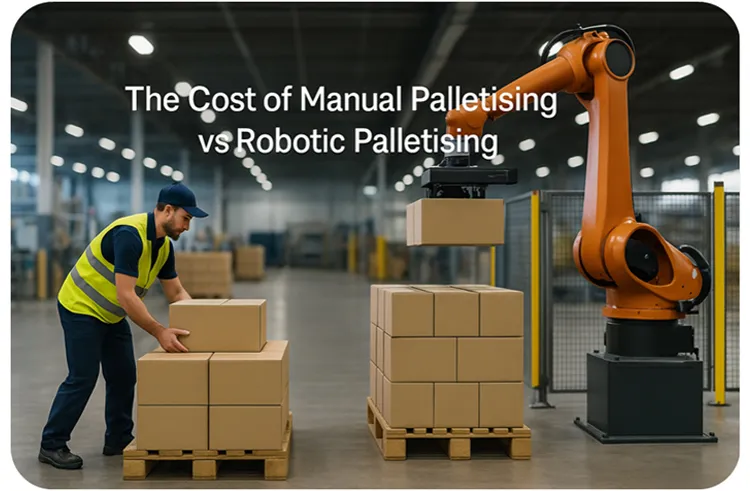
The Cost of Manual Palletising vs Robotic Palletising
Why Manufacturers Are Rethinking Palletising
The True Cost of Manual Palletising
For decades, manual palletising has been the norm across Australian manufacturing. It seems simple enough—workers lift boxes or pails from a conveyor and stack them onto pallets. But when you look closely, the true cost of this repetitive task extends far beyond hourly wages.
Manual palletising is physically demanding, inconsistent, and prone to human error. Productivity varies between shifts, fatigue sets in quickly, and minor mistakes can cause misaligned stacks or product damage during transport. Over time, these inefficiencies add up to significant cost and risk.
Rising Labour Costs and Safety Challenges in Australia
Labour availability has become one of the biggest challenges in modern manufacturing. With ongoing skill shortages, increasing wages, and higher WorkCover premiums, the cost of maintaining manual palletising operations continues to rise.
Repetitive strain injuries, back problems, and fatigue-related incidents are common in manual handling roles, creating hidden costs that extend to training, absenteeism, and staff turnover. Many businesses are now re-evaluating whether manual palletising is sustainable in a competitive market.
Understanding Robotic Palletising
What Is Robotic Palletising?
Robotic palletising automates the process of stacking products—such as cartons, pails, or bags—onto pallets using industrial robots or collaborative robots (cobots). These systems can be programmed to handle a wide variety of product sizes, shapes, and weights with speed and precision.
In Australia, Robotic Palletising is quickly becoming a mainstream solution for both large-scale and mid-sized manufacturers seeking to improve efficiency and reduce labour dependency.
How Robotic Palletising Reduces Operational Costs
Once installed, robotic palletisers operate continuously with minimal supervision. They don’t require breaks, shift changes, or sick leave, and they deliver consistent throughput every hour of every day.
Key cost savings include:
• Reduced labour costs through automation of repetitive tasks.
• Lower injury risk and fewer compensation claims.
• Increased uptime thanks to consistent performance and reliability.
• Reduced waste from perfectly aligned, damage-free pallet loads.
Safety, Efficiency, and Consistency Gains
Robotic palletising doesn’t just lower costs—it transforms the work environment. Operators are freed from repetitive lifting and can focus on higher-value tasks like quality control or logistics coordination.
The result is a safer workplace, improved morale, and measurable gains in efficiency.
Comparing Manual vs Robotic Palletising – A Cost Breakdown
Labour Costs and Workforce Availability
A single operator performing manual palletising can typically manage 6–8 cycles per minute, depending on carton size and weight. By contrast, a robotic palletiser can maintain a steady 15–25 cycles per minute—often handling the output of multiple operators simultaneously.
This means one Robotic Palletising system can replace two to three people per shift, saving hundreds of labour hours per week.
Productivity and Throughput
Manual systems are limited by human endurance and shift changes, whereas robots maintain full speed across all hours of operation. This is particularly beneficial for manufacturers running double or triple shifts, where ROI on robotic systems accelerates rapidly.
Workplace Health and Safety Costs
Every manual handling role introduces a safety risk. Sprains, strains, and repetitive motion injuries lead to downtime and increased insurance costs. Robotic systems virtually eliminate these risks, protecting both employees and the business from costly disruptions.
Maintenance, Downtime, and Longevity
Manual operations rely on people—who get tired, need breaks, and vary in output. Robotic systems, on the other hand, are built for long service life. With routine maintenance and remote support, many Process Evolution systems operate reliably for over a decade, delivering consistent performance day after day.
The ROI of Robotic Palletising
Typical Payback Periods for Australian Manufacturers
Depending on labour costs, production hours, and product type, most Australian manufacturers see a return on investment in 12–24 months. For multi-shift operations, the payback period can be even shorter.
Savings come from reduced labour, fewer injuries, improved efficiency, and less downtime.
Multi-Shift vs Single-Shift Operations
Even in single-shift operations, robotic palletisers offer strong ROI due to reliability and labour reallocation. However, when systems run across two or more shifts, the financial advantage grows exponentially. Robots perform consistently regardless of time or operator fatigue.
How Process Evolution Calculates ROI for Clients
At Process Evolution, we work closely with clients to model total cost of ownership and forecast ROI. Our engineers consider labour rates, current palletising throughput, downtime, and product variability to provide clear, data-driven projections before a system is even built.
Choosing the Right Type of Robotic Palletising System
Bespoke Industrial Palletising Cells
For high-volume production lines with consistent SKUs, a fully integrated industrial robotic cell offers unmatched speed and automation. These systems can include pallet dispensers, wrapping, and labelling for a complete end-of-line solution.
Flexible Cobot Palletisers
Cobot palletisers are ideal for smaller batch operations or mixed SKU environments. They’re easy to program, quick to redeploy, and safe to work alongside operators.
They’re the perfect entry point for manufacturers wanting to begin their automation journey without major layout changes.
Dedicated Cobot-Style Palletising Machines (Like the AWP Model)
Our AWP palletising systems combine the flexibility of cobots with the speed and rigidity of industrial robots. Designed for repeatable, consistent palletising, these compact systems are a powerful solution for businesses that want efficiency, safety, and simplicity in one package.
Why Partner with an Australian Automation Specialist
Systems Built and Supported Locally
At Process Evolution, we design, assemble, and support our robotic palletising systems right here in Australia. Local manufacturing ensures fast lead times, tailored solutions, and access to local engineers who understand your industry and site requirements.
Compliance with Australian Safety Standards (AS/NZS 4024)
All Process Evolution systems are designed and built to meet or exceed AS/NZS 4024 safety standards. Our team ensures every installation is compliant, certified, and safe for ongoing operation in any manufacturing environment.
Long-Term Service, Support, and Spare Parts Availability
Because we’re based locally, support is never far away. We provide service, training, and spare parts directly from our Australian facility, ensuring your system runs reliably year after year with minimal downtime.
The Long-Term Value of Automation
Lower Cost per Pallet Over Time
Once installed, the total cost per pallet for a robotic system decreases dramatically over time. Unlike manual labour costs that rise year on year, a robotic palletiser’s main expenses—maintenance and energy—remain predictable and low.
Improved Workforce Safety and Retention
Automation not only protects workers but also makes manufacturing a more attractive career path. Employees value modern, technology-driven workplaces that reduce physical strain and improve overall job satisfaction.
Building a Future-Ready Manufacturing Operation
By investing in Robotic Palletising, Australian manufacturers are building resilience against labour shortages and global supply chain disruptions. Automation future-proofs production capacity and creates scalable, flexible operations.
Conclusion: The Smart Investment for a Competitive Future
When comparing manual palletising to robotic palletising, the numbers speak for themselves. Lower labour costs, improved safety, higher productivity, and faster ROI make automation an obvious next step for forward-thinking manufacturers.
At Process Evolution, we combine engineering expertise with local knowledge to deliver reliable, Australian-built palletising systems that help businesses stay competitive, efficient, and ready for the future.
Ready to calculate your ROI?
Speak to Process Evolution today to explore how Robotic Palletising can reduce costs, improve safety, and transform your end-of-line operations.

